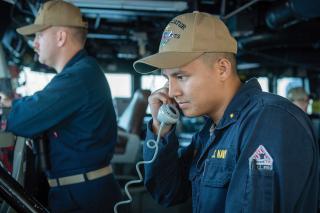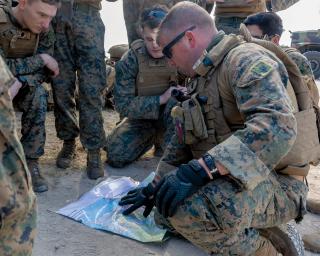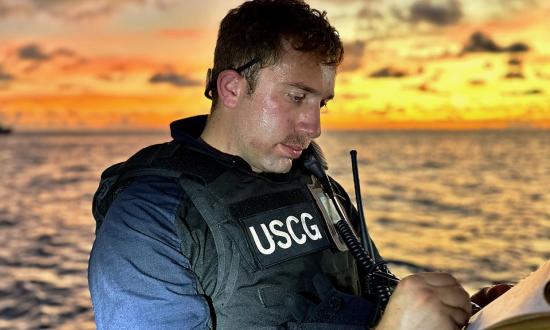Kneeling at the center of a security perimeter late at night on my first full mission profile as a SEAL, I could not figure out my purpose as a junior officer. My platoon was culminating our maritime operations training with an over-the-beach infiltration involving a complicated array of aerial and maritime layers. My platoon commander opted to remain in one of the boats to keep the highest possible situational awareness. As ground-force commander (GFC), he sent me ashore in the landing team as his surrogate assault-force commander.
I was thrilled at the early leadership opportunity. My job was to provide updates to the GFC and manage unexpected contingencies with the on-the-ground tactical leader—an enlisted operator with many more years of experience than I had. After a boat transit, we swam ashore and formed the perimeter. I took my place in the center with the tactical leader and worked on radioing back to the GFC. My equipment did not work. I let the tactical leader know I needed a few minutes to troubleshoot and was told, “We don’t have time, figure it out later.”
I never got my communication equipment to work that night and did not speak with my GFC until we climbed back into the boat and saw him face-to-face. The tactical leader led the team through a couple of minor contingencies without my help. When I took stock toward the end of the mission, kneeling in the middle of the perimeter—rather than taking a security position on the outside—was the extent of my command.
I had heard the question before, but this was the first time I wondered it to myself: Why do we even need junior officers (JOs)?
Authority Without Experience Creates Opportunity
In my community, almost every sailor has a college degree. Most have work experience outside the military. When I checked into my first command, I was just as inexperienced in our tactics and operations as any other “new guy.” So why do I wear a bar? Why do I get additional responsibility? Why do I outrank every enlisted service member, up to and including the command master chief? I assume sailors and Marines across the fleet have similar questions about their newly commissioned officers, regardless of community. I know all JOs feel insecure about how their authority stacks up against their experience.
Maybe the JO position is only a breeding ground for senior officers. Maybe the Navy does not need division officers. Maybe the deckplate-level functions of ships, squadrons, battalions, or teams would happen just as smoothly—or more so—if run solely by senior enlisted leaders. But the Navy does need executive officers and commanding officers and admirals, and those people must start somewhere. Sticking them on the deckplates gives them an opportunity to gain experience and practice “leadership” until the Navy needs their leadership later in their careers.
Maybe the JO position is a recruiting tool. Maybe having a more prestigious career path that promises faster advancement attracts talent who would otherwise not choose military service.
Maybe professional officers are a vestige of a much earlier, class-based military in which foot soldiers served at the behest of a higher-caste commander. Maybe it is not just a vestige but a function of today’s less overtly class-based military. Maybe the only reason I was selected as an officer candidate is because of advantages I have had since birth.
None of those explanations fully encapsulates the purpose or responsibility of a JO. In fact, the seemingly irreconcilable contradictions JOs face—authority with inexperience, responsibility with naiveté, striving for the approval of sailors and Marines while striving to be proficient at the mission—is exactly the thing that makes JOs valuable.
Embrace the Oath
JOs are given the opportunity to decipher how they are supposed to lead on day one of service. Embedded in the oath of office is a fundamental idea binding officers to a different responsibility than their enlisted counterparts. At the very beginning of a naval career, there is a subtle difference between the oaths commissioned officers and enlisted sailors take.
Both oaths begin: “I will support and defend the Constitution of the United States against all enemies, foreign and domestic; that I will bear true faith and allegiance to the same.” The officers’ oath continues, “that I take this obligation freely, without any mental reservation or purpose of evasion, and that I will well and faithfully discharge the duties of the office on which I am about to enter.” Clauses such as “without any mental reservation or purpose of evasion” and “well and faithfully” invoke a level of trust granted the junior officer at the outset. This trust allows small units to function efficiently because the oath of enlistment requires sailors and Marines “to obey the orders of the President of the United States and the orders of the officers appointed over me, according to regulations and the Uniform Code of Military Justice.”
Mentors of mine have described the division of leadership between officer and enlisted ranks as being characterized by “up and out versus down and in.” Officers manage assets and issues not organic to the unit while ensuring higher commander’s intent is met. Enlisted leaders manage issues within the unit while ensuring actions are taken that will meet the officer’s intent. Regardless of the unit’s task and purpose, officers are responsible for the actions of their unit and mission accomplishment while senior enlisted leaders manage the readiness and day-to-day actions of that unit. A successful element must have a seamless joining of the two realms in garrison or while operational.
JOs are expected to divide their attention almost exactly down the middle of this spectrum. JOs must become proficient at their unit’s job by acting as a peer with the newest enlisted members but also must understand the “up and out” to grow as an officer. When a new sailor and a new officer arrive at a command, they are in almost the same place. They both know little about how a unit runs and must learn the basics. But, despite their similarities, they have different jobs established by their different oaths. A sailor’s oath to “obey the orders of the officers appointed over me” makes the sometimes muddled, confusing business of supporting and defending the Constitution simple. A JO takes an oath that sailors can trust him or her, from day one, with interpreting what supporting and defending the Constitution looks like. This is not just the charge of senior officers—it is the charge of all officers, including the young ones on the deckplates, learning the basics.
Bridge the Gap
Despite JOs’ inexperience, they are entrusted with many dangerous and pivotal tasks because of the responsibility granted to them by the Constitution and by their commission. Most of the time, on an underway ship, the officer of the deck is a junior officer, delegated the safety not only of a strategic national asset, but also all the sailors on board. In aviation squadrons, JOs account for the most flight hours on the schedule. The first watch a JO qualifies for on a nuclear submarine is engineering officer of the watch, ensuring the reactor sustaining the boat and the crew is working properly. As assault-force commander, I was responsible for more than just communications. I was the GFC’s direct representative and therefore accountable for my part of the operation.
All the above are “down and in” functions. They occur routinely at the deckplate level, yet they are no-fail missions entrusted to JOs. Unit commanders need subordinate commanders—young leaders who have the same Constitutional responsibility they do—to complete these tasks so enlisted leaders can focus on making the bulk of the deckplate functions happen. JOs are uniquely suited for these responsibilities.
Perhaps the best part of being a JO is using our seats at the “up and out” table to make the lives of sailors and Marines better, while still accomplishing the mission. The forward-deployed, underway electrical officer who managed to get her junior sailor off the ship and back to the states in time to see the birth of his first child. The Marine second lieutenant who routed up a request to a flag officer for a beer to await members of his unit at a stop on their way home from deployment. The SEAL qualification training (SQT) student who was authorized a house in town and invited his entire SQT class to come over for Thanksgiving when they might not otherwise have had a place to go. The infantry platoon commander who was notified that there had been a suicide attempt in his platoon but did not know who it was. He dropped everything and called every single Marine to check in on them. Just in my immediate circle, these are examples of JOs who leveraged “up and out” to affect “down and in.” They straddled two seemingly incompatible roles and did it in a way that made the force better.
The naval service needs junior officers not just to produce senior officers in 20 years, or to recruit talent, or because societal castes must be reflected in the U.S. military. JOs must be leaders now: Our oath mandates it. We must pour ourselves into both “down and in” and “up and out.” There is no one better postured for bridging this gap than a junior officer. While learning the basics and learning to lead, we have a lot more to offer than kneeling in the middle of the perimeter.









